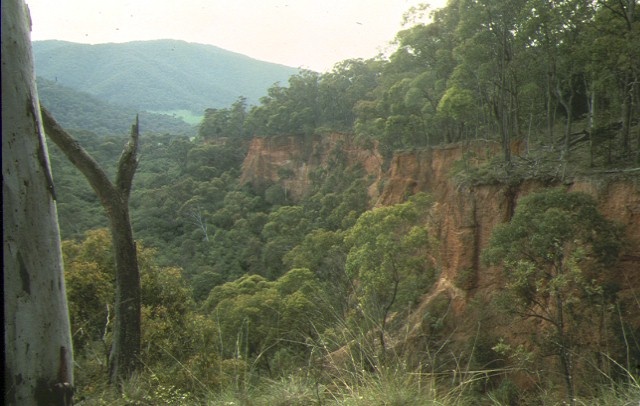PIONEER AND UNION HYDRAULIC GOLD SLUICING SITE
OMEO HIGHWAY MITTA MITTA, TOWONG SHIRE
-
Add to tour
You must log in to do that.
-
Share
-
Shortlist place
You must log in to do that.
- Download report


Statement of Significance
What is significant?
The Pioneer and Union Hydraulic Gold Sluicing Site consists of a vast network of sluicing faces, pebble dumps, tail races and water races. Water for sluicing was brought to the site by a 20km long water race and then directed by high pressure pipelines and nozzles at the gold bearing deposits. The technology was introduced into Victoria in about 1855. The Pioneer Company, in 1884, were the first to use this type of mining on the Mitta Mitta goldfield. The Pioneer Claim is reputedly to have been the largest operation of its type in the State, with approximately 20 hectares of ground being mined between 1859 and 1913 leaving walls up to 75 metres in height.
How is it significant?
The Pioneer and Union Hydraulic Gold Sluicing Site is of historical, archaeological and scientific importance to the State of Victoria.
Why is it significant?
The Pioneer and Union Hydraulic Gold Sluicing Site is historically and scientifically important as a characteristic and well preserved example of an early form of gold mining. Gold mining sites are of crucial importance for the pivotal role they have played since 1851 in the development of Victoria. Hydraulic sluicing of alluvial gold deposits is an important key ingredient in an understanding of gold mining technology as it was employed in country where water was plentiful and perennial.
The Pioneer and Union Hydraulic Gold Sluicing Site is archaeologically important for its potential to yield artefacts and evidence which will be able to provide significant information about the cultural history of gold mining and the gold seekers themselves.
-
-
PIONEER AND UNION HYDRAULIC GOLD SLUICING SITE - Permit Exemptions
General Exemptions:General exemptions apply to all places and objects included in the Victorian Heritage Register (VHR). General exemptions have been designed to allow everyday activities, maintenance and changes to your property, which don’t harm its cultural heritage significance, to proceed without the need to obtain approvals under the Heritage Act 2017.Places of worship: In some circumstances, you can alter a place of worship to accommodate religious practices without a permit, but you must notify the Executive Director of Heritage Victoria before you start the works or activities at least 20 business days before the works or activities are to commence.Subdivision/consolidation: Permit exemptions exist for some subdivisions and consolidations. If the subdivision or consolidation is in accordance with a planning permit granted under Part 4 of the Planning and Environment Act 1987 and the application for the planning permit was referred to the Executive Director of Heritage Victoria as a determining referral authority, a permit is not required.Specific exemptions may also apply to your registered place or object. If applicable, these are listed below. Specific exemptions are tailored to the conservation and management needs of an individual registered place or object and set out works and activities that are exempt from the requirements of a permit. Specific exemptions prevail if they conflict with general exemptions. Find out more about heritage permit exemptions here.
-
-
-
-
-
PIONEER AND UNION HYDRAULIC GOLD SLUICING SITE
 Victorian Heritage Register H1229
Victorian Heritage Register H1229 -
Miner's Cottage
 National Trust
National Trust
-
'Altona' Homestead (Formerly 'Laverton' Homestead) and Logan Reserve
 Hobsons Bay City
Hobsons Bay City
-
-











